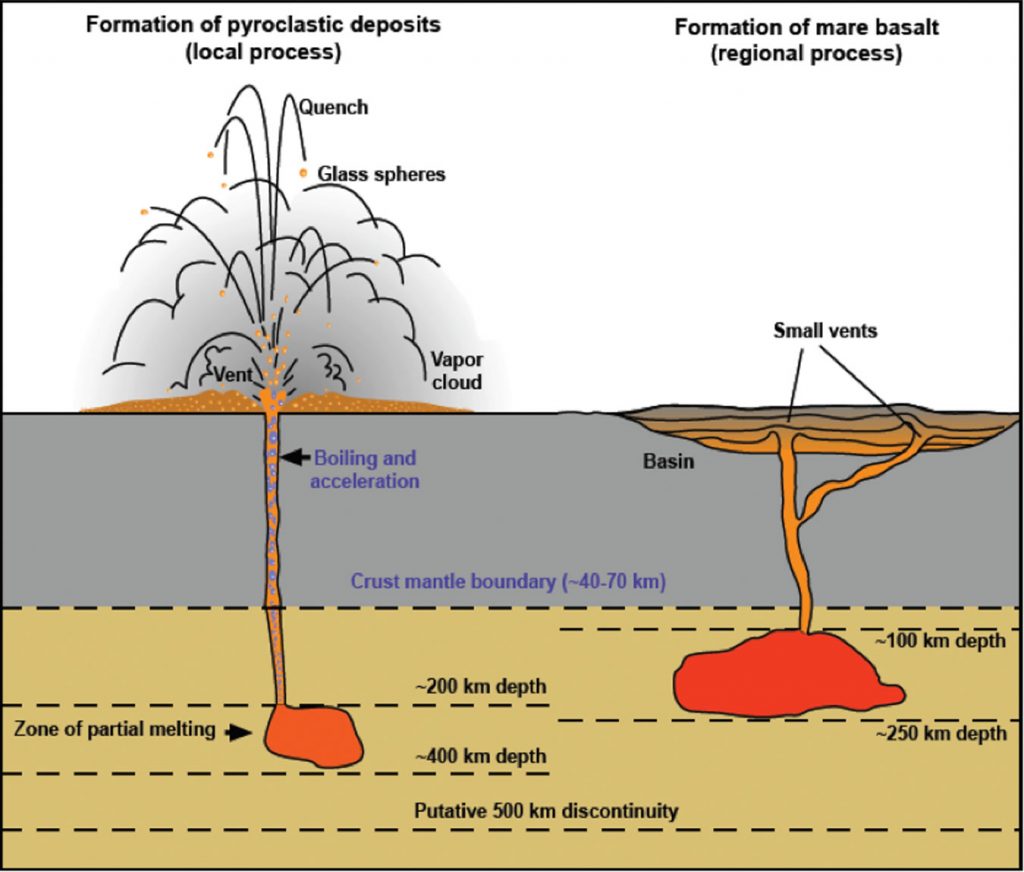Volcanism has been a major field of study in the lunar science community, from determining more precise ages of mare lava flows, evaluating the eruption history of deposits found across the lunar surface, and what explosive pyroclastic deposits can tell us about the composition of the lunar interior. Lunar volcanic deposits are dominated on the surface by mare lava, which in-filled regions of topographic lows, such as impact basins, primarily on the lunar nearside. Mare volcanism occurred over a period of 1.3 billion years from ~3.8 to 2.5 Ga (giga-annum), however, the exact age of the youngest mare eruption is still under debate (argued to be millions of years instead of billions of years old).
The study of lunar volcanism involves two main streams: analyzing remote sensing data acquired by lunar spacecraft (e.g., Lunar Reconnaissance Orbiter, Clementine, and Kaguya/SELENE), and analyzing the mineralogy, textures, and chemistry of Apollo rock samples. Although there are a few different types of volcanic structures on the lunar surface (rilles, pyroclastic vents, mare lava plains, lava pits, and domes), two types of volcanic rocks are studied by scientists: mare and pyroclastics.

Mare Lava
Mare lava, or better known as lunar mare, cover >15% of the lunar surface, with most of this occurring on the lunar nearside. These mare lava flows or plains appear as dark topographic features and can be seen with the naked eye from the surface of Earth. The composition of mare lava is basalt, similar to the lava flows we observe erupting from the hot spot islands of Hawaii. The size of lunar mare ranges from >200 km to ~2600 km, with the largest feature, the Oceanus Procellarum, being 2590 km. The thickness of mare ranges from ~500 m to 1500 m, with individual lava flows proposed to exhibit thicknesses from 10 m to 20 m implying that mare deposits are the product of several overlapping eruptive events.
The age of mare deposits have been determined using a combination of radiometric dating of Apollo samples and the crater counting technique. Radiometric dating of Apollo mare samples provides a range of ages from 3.16 to 4.2 billion years, and crater counting provided a young age of ~1.2 billion years. Overall, majority of mare eruptions occurred between 3 and 3.5 billion years. Very few eruptions occurred on the farside of the Moon, and this is interpreted to be a result of the farside exhibiting a thicker crust compared to the nearside. The youngest lava flows are found in Oceanus Procellarum.
Pyroclastic Deposits

Explosive volcanic deposits on the Moon, which includes pyroclastic deposits (mounds and/or flows comprising volcanic ash, dust, and fragmented crustal rocks), have been a sought after geologic material since before the first Apollo launch. Their popularity in the lunar science community stems from two reasons: (1) the magma source of pyroclastic deposits are deeper than mare lava and other effusive volcanic eruptions (dome structures). Sampling magma source rocks from pyroclastic deposits and glass spherules (particles of volcanic glass) with trapped gas and fluids would allow scientists to understand the chemical source of explosive volcanism on the Moon, constrain the exact depth at which magma sources were present, and determine the concentration of volatiles in the deep lunar mantle providing new insights into the volatile evolution of the Moon. (2) Explosive volcanic deposits contain a greater concentration of volatiles (e.g., water) than effusive mare lava and domes. Volatiles are a target of interest for space agencies and private space sector companies, because they can be used for sustainable resources in lunar and deep space human missions, and help address high priority science goals regarding the origin and evolution of volatiles in the solar system, and understand the early volcanic history of the Moon.
